Dr Mahesh Gadekar/ July 28, 2020/ Dr Mahesh Gadekar, Geoenvirovision, Health, Rain water harvesting, Water, Water Quality/ 0 comments
Quality of Roof Harvested Rainwater
Brief Idea for quality of roof harvested rainwater.
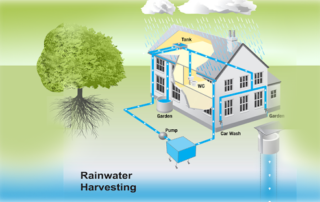
The rooftop rainwater harvesting is the alternative source of the water which is used for the drinking purpose, toilet flushing, and washing cloths, etc. so that studies regarding the water quality should be done for the use of this water for the above mentioned various purposes. Various treatments and disinfection will be required prior to release of roof runoff water either into surface water or for direct consumption usage. For microbial contamination, current proposed standards and guidelines regarding this type of water vary widely worldwide.
The world is facing tremendous demand of good quality of water for the daily use. The current sources of the water are surface and ground water. The current trend increases the use of the not only surface water and ground water but also the rain harvested water. Identification of chemical and biological hazards as well as technical and esthetical problems are critical issues, that have to be dealt with within the initiatives for development of sustainable solutions for handling and reuse of water, both wastewater and urban runoff. The collection and the storage of the rainwater to supplement existing water supplies could alleviate some of these problems. Rainwater utilization may be one of the best available methods for recovering the natural cycles and aiding in sustainable urban development. Due to the human urbanization, the amount of the impermeable areas has increased which contribute to the problems involving the runoff flooding, runoff contamination and storm water management. There are two types of rainwater collection system i.e. system using the surface/ground water catchment areas, and those using above the ground rooftop catchment areas.
The major limitations for collection and use of rainwater are the risks related to handling of water with poor quality. The content of different types of pollutants (chemical, physical and microbiological) is largely determined by the type of surfaces (roofs, roads, parking lots, pavements etc.) used for collection of the rainwater, but also by the air quality, as well as human and animal activities at a specific site. Each pollutant may lead to potential problems depending on the usage in question, either hazards regarding exposure of humans, animals, crops or plants, or technical and esthetical problems.
A problematic pollutant is, in this context, defined as any compound or microorganism causing any type of negative effect during treatment and use of the water.
In Denmark, use of rainwater for toilet flushing and washing of clothes is already legal and technical guidelines are issued to ensure that future rainwater systems are constructed properly in order to minimize health risks. The results from the present study will form the basis for future regulations that may legalize use of rainwater for further purposes. The same generic principles of hazard assessment could also be used in other climatic or cultural regions with other possible reuse applications
Now being there, numerous rainwater collection systems constructed across the world for non-potable uses such as landscape irrigation, toilet flushing, and clothes laundering, countries such as Germany, India, Denmark, Japan, and Australia are leaders in the installation of systems for the collection of rainwater from rooftops with storage areas and distribution lines within individual households. The national legislative bodies in many of these countries are drafting legislation requiring all new construction to incorporate rainwater-harvesting systems for flushing toilets and external water uses.
A literature survey revealed that a total of 63 metals, 640 xenobiotic organic compounds, 33 microbiological parameters and 119 general physical and chemical parameters have either been identified or could potentially be released to the rainwater before collection. These pollutants need to evaluate for the reuse of the water. The hazards regarding human exposure taken into consideration were infectious diseases, cancer, allergic reactions, mutagenic changes, and reproductive effects. The technical problems considered were precipitation and corrosion, and compounds causing discoloring and odors were included due to their aesthetically value.
There is a growing demand in society for introducing decentralized systems providing opportunities to save and reuse water. This development is driven by water shortage in several parts of the world, but also by awareness that the centralized urban water systems used for treatment of both urban runoff and wastewater are expensive and resource consuming. One way to reduce the need for freshwater and at the same time reduce urban runoff peak flows is to collect and use rainwater, after some decentralized treatment (low or high tech), or without any treatment at all, depending on the water quality and the use applications. Possibilities for using collected rainwater are in laundry machines or for urinal and toilet flushing, as illustrated in Figure 1. Vehicle and window washing, fire protection and concrete production are examples of other suggested use applications. Outdoors, irrigation and infiltration into the ground are obvious alternatives.
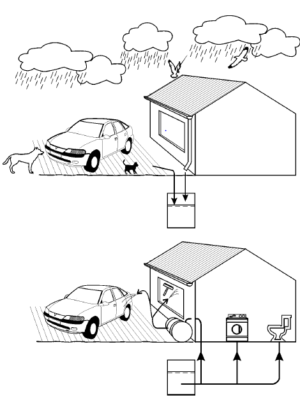
Chemical Contamination
In the 1970s and 1980s, countries began attempting to reduce pollutant loads in the storm water discharges by infiltrating the runoff from streets and rooftops into soil instead of directly into storm water system. This practice led to numerous studies involving possible chemical contamination of roof runoff from these urban catchments.
A number of studies have indicated that rooftop runoff can be a major contributor of heavy metals to aquatic ecosystem. At the time of the rainfall, high pollutant concentration occurs in first fall and these high pollutant concentration decreases by time. This pattern of roof runoff with initial high levels of pollutants was described as ‘first flush effect’ and could be predicted mathematically by a negative exponential function. Forster’s studies also identified that pollution level of runoff from different roofs within small area were highly variable, dependent upon seasons, and also variable within the single precipitation event.
The storm-water runoff from urbanized lands has the potential to change the health of water bodies, impacts on aquatic habitats, recreation, and aesthetics, or cause algae to grow uncontrollably. Pollutants found in urban storm-water runoff originate from a number of sources: washings of road surfaces, parking lots, motor vehicles, building materials, air pollutants, exhausts from industrial operations, and lawn fertilizers. Among the pollutants, heavy metals are a serious concern because of their tendency to bioaccumulation.
The risk assessment of new and existing chemicals, according to the technical guidance document for risk assessment of chemicals in European Commission (EU) is illustrated in FIGURE 2. Risk assessment of chemicals is composed of four elements: hazard/problem identification, hazard/problem assessment, risk characterization, and risk management. The cycle to the left illustrates that the risk assessment is not a linear process but that iterations in the four steps are necessary depending on the problem in focus and the data material available.
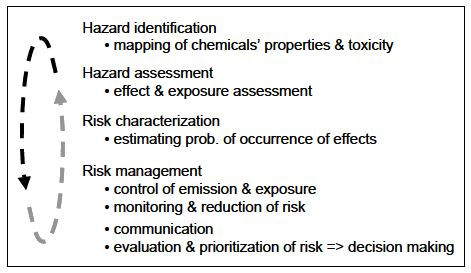
In general, hazard identification serves to map the inherent properties of chemicals by collecting and comparing relevant data on e.g. physical state, volatility, mobility, potential for degradation, bioaccumulation, and toxicity. Hazard assessment is divided between exposure assessment and effect assessment. Comprehensive model systems have been developed to assess the distribution of contaminants in the environment (soil, water, air) and in tissue (animals, humans). Next step is risk characterization, where the potential negative effects are evaluated and, if possible, the probability of effects occurring is estimated. Finally, risk management involves a range of possible interventions, i.e. monitoring and reduction of risks by control emissions and the exposure of sensitive environments.
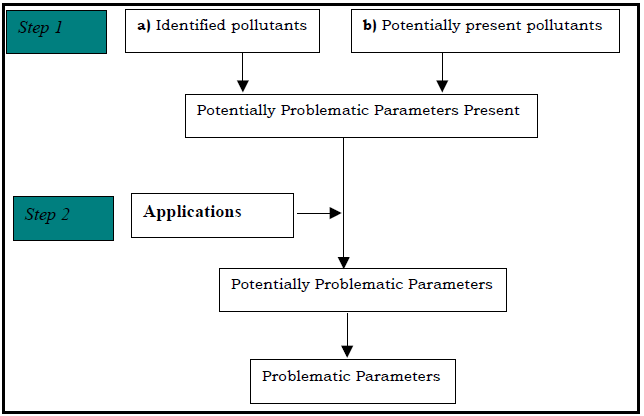
The study was restricted to only include human health hazard identification and problem identification focused at technical/esthetical issues concerning use of collected rainwater. This is furthermore restricted to collection of some specific information related to the applications for use of the collected rainwater as described below in FIGURE 3.
Long-term exposure to chemicals commonly present in the rainwater runoff from rooftop collection areas are known to cause numerous biological disorders. Despite the fact that many chemicals accumulate in living tissues over time, there are no reports concerning health risk associated with human contact, inhalation, or ingestion of rainwater runoff containing human contact, inhalation, or ingestion of rainwater runoff containing chemical pollutants (CDC, 2009). Health risk associated with chemicals such as biocides, pesticides, herbicides, petroleum hydrocarbons, and organ halogens that may also found in the runoff.
Rainwater collected from the sources that potentially are contributing to the pollutant load in collected rainwater is as follows
- 1. Atmospheric deposition: Wet and Dry.
2. Releases from materials:
2.1. Buildings, including roofs, carports, fences and playgrounds: Building materials, Paint and varnish, Roofing-felts, Pigments, Roofing tiles, Filling material, Bricks, Weld and joint materials, Metal roofs, Putty, Gutters and drainpipes, Glues, Roof cements, Rock and mineral wool, Thatched roofs, Window profiles, Fiber cement, asbestos free roofs, Window glass, Concrete, Doors, Cements, Facings, Wood, Facing plasters, Plastics, Tanks and reservoirs, and Wood impregnating agents, etc
2.2. Roads, paths and pavements: Asphalt, Bitumen, Cement, Dust,
2.3. Vehicles: Brakes, Tires, Exhaust fumes, Windscreen washer fluids, Petrol, and oils, others like crankcase oils, antifreeze mixtures, brake fluids
3. Human activities
Chemical dispersion: Pesticides, Road salts, Spillage and Fire-extinguishing agents.
4. Animal activities: Excrements.
The study done by Simmons et al. on One Hundred and twenty five domestic rooftop rainwater harvesting systems in Auckland district for level of the heavy metals (Zink, Copper, and Lead). Their study found 14% of the systems exceeded New Zealand levels for lead in the drinking water. 2% for the copper levels and 1% exceeded zinc guidelines. The study of Gromaire et al. had studied rainwater discharges from urban areas of Paris, France, which composed of the 54% of rooftop area, 22% of streets, and impervious miscellaneous structures. Roof materials were on site are zinc sheet, slate, interlocking tiles, and flat tiles. Different material for guttering zinc, copper, and cast iron were studied. Literature also presented that the 80% of the cadmium, lead, and zinc contamination in the combined sewer system.
Heavy metals are either dissolved in the storm water or are bound to particulates (Sansalone and Buchberger 1997). However, their presence and concentrations are strongly site-specific. Studies done in Ashdod, Israel showed that the trace metal concentrations in storm-water runoff were in the following ranges: manganese (0.001–0.516 mg/L), zinc (0.008–0.720 mg/L), copper (0.001–0.079 mg/L), and lead (0.003–0.010 mg/L). In another characterization study, Walker et al. (1999) summarized the concentrations of heavy metals in urban runoff in the following concentration ranges: zinc (0.0007–22.0 mg/L), copper (0.00006–1.41 mg/L), and lead (0.00057–26.0 mg/L)
In study of Vijayaraghavan, Joshi, & Balasubramanian, 2010, seven low-cost sorbents were screened on the basis of their heavy metal removal efficiency from urban storm-water runoff. Of these sorbents, crab shell performed well with removal efficiencies over 93% for different metal ions including Co, Cu, Pb, Mn, Zn, Ni, and Cd. Being abundantly generated as waste in seafood industries, the disposal routes of crab shells have become increasingly restricted. For example, landfill is not permitted for raw or untreated seafood waste disposal. Hence, an alternative route such as efficient reutilization of these seafood wastes for environmental applications is highly desired by seafood industries. The results of this study indicate that crab shells can be used for the removal of trace amounts of heavy metal ions from storm water runoff. The current study also highlighted possible applications of crab shells in biofilters. However, additional research needed to control the leaching of calcium and magnesium from crab shells.
MICROBIAL CONTAMINATION
Microbial contamination is the most important in concern of the quality of the rooftop-harvested water. Microbial contamination can occur due to the leaky, incorrect design of the tank. These may transferred by the vectors like a rat, lizard or insect or because of an accident. It may be fatal in some cases if not taken seriously towards the point of microbial contamination.
When considering the water quality of a roof water system, it is useful to observe the complex path a contaminant must follow in order to enter a human being. Figure 4 presenting the contamination paths for roof water harvesting.
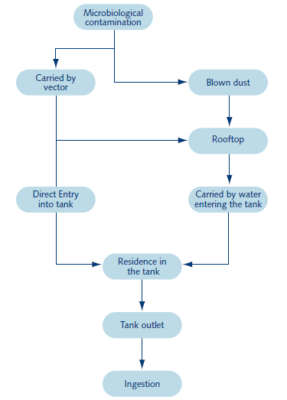
By far the largest contribution will come from material that has accumulated on the roof or blown onto the roof during a storm. Accumulated material may have been blown onto the roof by the wind, stirred up by passing vehicles, dropped from overhanging trees, or deposited by an animal (or person) with access to the roof. Passage of water along unclean gutters may add further debris (Martinson, 2007).
Table 3 Examples of water quality criteria for toilet flushing
| Country | Fecal Coliforms | Total Coliforms |
| CFU/100 ml | CFU/100 ml | |
| United States | Zero | Zero |
| Germany | 100 | 500 |
| Japan | 10 | 10 |
| United Kingdom | Zero | – |
| Canada | 200 | – |
Standards for microbiological contamination levels of various water types vary greatly throughout the world. This is in stark contrast to the recognition for levels of the chemical contamination, which have reached almost universal agreement worldwide. Methods of chemical analyses, chemical detection limits, and chemical water quality standards are similar for all parts of the world. For microbial standards however, there is lack of global agreement regarding water quality guidelines and health related standards. Table 3 shows a general lack of clarity regarding water-recycling schemes used for toilet flushing (Ley Dennis, 2009).
A large number of studies measure indicator bacteria, such as total or thermo-tolerant coliforms, in rainwater systems. Most have shown indicator bacteria in rainwater tanks in some quantity but that this quantity has large variations both from system-to-system and over time, with readings changing several orders of magnitude within a few days. The reason for this is that the water becomes contaminated though the addition of material washed in from the roof, but over time contamination levels reduce due to settlement and die off within the tank. This can be seen in Figure 5 where the levels of indicator bacteria rise after rains and then fall over time until the next rain. Reductions of 90% have been noted after about 3 days, though this will change somewhat with local conditions (Martinson, 2007).

Microbiological quality standards range from relatively simple to relatively complex. If the water is intended for the human contact or consumption, it must be fully treated to the potable standards required by individual country. However, there are often exceptions where a lesser standard for human contact used rather than for the human consumption. For example, the water quality standards required for swimming in environmental water is deemed adequate for water used for bathing, showering, and laundry purposes within household. In more complex water reuse systems, a variety of quality standards and recommendation treatments are applied for 1) Human consumption/contact, 2) for non-contact situations, and 3) For ecological uses such as irrigation waters. (Ley Dennis, 2009)
There are a few reports of gastroenteritis associated with Campylobacter, which is carried by birds, however the cases reported are either in immuno-compromised subjects (such as a chemotherapy patient) or have rainwater listed alongside several other possible causes (such as the consumption of poultry). One outbreak of Giardia/Campylobacter has been reported. This was the result of poor sanitation practice where the outfall from a leaking septic tank entered an underground rainwater tank. There have been a small number of epidemiological studies involving households using RWH systems. They show that households drinking rainwater have no greater risk of gastrointestinal illness than those drinking from groundwater sources or, in one study, than those using chlorinated public mains water. The lessons that can be drawn from these cases is that good practice is essential in maintaining good health when using rainwater for drinking. However if good practice observed, systems should provide good quality water. Special arrangements such as boiling, SODIS or bio-sand filtering may be appropriate for the very young, the very old, or those whose immune system is reduced (Martinson, 2007).
A clear consensus on the water quality and health risk associated with rooftop collection system depends on the use of water and the maintenance of the system. Untreated rainwater collection system may constitute a risk for contamination of public drinking water systems if proper guidelines back-siphonage, leakage, and incorrect installation with cross-connection are not designed into each system. This is especially pertinent to community system worldwide that do not maintain disinfection residuals throughout the water system. So that the properly designed, constructed and maintained systems involving roof harvesting and tank stored rainwater were acceptable quality for drinking and cooking purposes.
German study involving 102 German rainwater collection systems used for toilet flushing, garden irrigation, and cloths washing, seven different specific potential microbial pathogens were surveyed and only on pathogen (pseudomonas) was detected only in 12% of the total samples. One hundred and twenty five domestic rooftop rainwater systems in four rural Auckland district by Simmons et al. (2001) Samples from cold-water faucets were analyzed for the chemical and microbiological contamination. Their study suggested that rooftop rainwater was relatively of poor quality. Potential microbial pathogens such as Salmonella, Aeromonas, and cryptosporidium were identified in some of rooftop-collected rainwater. Their survey also suggested a significant association between presence of Aeromonas and increased gastroenteric symptoms amongst household users (see Table 4). (Ley Dennis, 2009)
Table 4 Prevalence of microbial pathogens in roof collected rainwater from the 125 Aucklands household
| Microorganism | Number of Samples | Prevalence % |
| Aeromonus Spp. | 125 | 16 (20) |
| Campylobactor jejuni | 115 | 0 |
| Salmonella Spp. | 115 | 0.9 (1) |
| Legionella Spp. | 23 | 0 |
| Giardia Spp. | 50 | 0 |
| Cryptosporidium Spp. | 50 | 4 (2) |
REDUCING HEALTH RISKS
As the water must pass from the roof to the tank inlet, the conveyance is a good place to put a filter to block any contamination from entering the tank. The vast majority of chemical and microbiological contaminants will be stuck to debris from the roof so removing the debris will also remove the contaminant. Removing debris also reduces the level of nutrient reaching the tank and thereby impedes mosquito larvae development and long-term survival of bacteria (Martinson, 2007).
For first flush contamination: The simplest is to move the downpipe to one side at the start of a rain episode so that it spills water onto the ground instead of into the tank (Martinson, 2007).
The quality of water stored in a tank improves with time. Small particles sediment out and bacteria die off. Water entering the tank tends to be both colder and of a lower quality than the stored water in the tank and it is desirable that the new water should not mix with the older water. The best way to do this is by arranging the inlet so that it goes all the way to the bottom of the tank as shown in Figure 9.6a. A ring of material surrounding the inlet will break the downward flow and prevent it from disturbing any settled material. With this arrangement, the incoming water will remain in a zone on the bottom of the tank and will not disturb the cleaner water above it (Martinson, 2007).
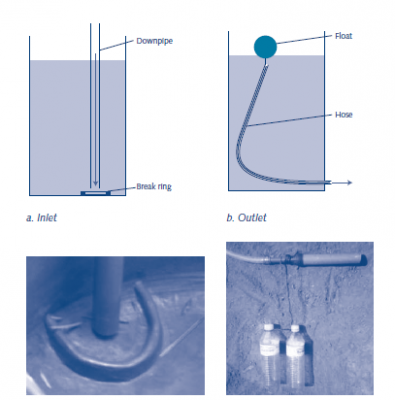
Post treatments were required there may be chances of the E. Coli in the tank water but as the settled tank water is very clear, this is particularly true of treatments that rely on light penetration such as SODIS, UV sterilization or very fine filtration such as Bio-sand.
Guidelines for the rooftop runoff collection systems are being developed throughout the world. Important parameters reviewed in this for the optimum performance of the rainwater harvesting collection systems are:
- Proper design of the all parts of rainwater harvesting systems.
- Exposed heavy metal surfaces contribute to runoff coefficients.
- Coating of metal surfaces rooftop material minimizes leaching.
- The type of impervious roofing material used is secondary to the material deposited on roof catchments as source of the contamination.
- Proper treatment/disinfection method should be used.
- Regular maintenance for existing systems.
- Intended use of the water.
- Education and certification of individual associated with the governing, approval, and usage of these types of systems.

